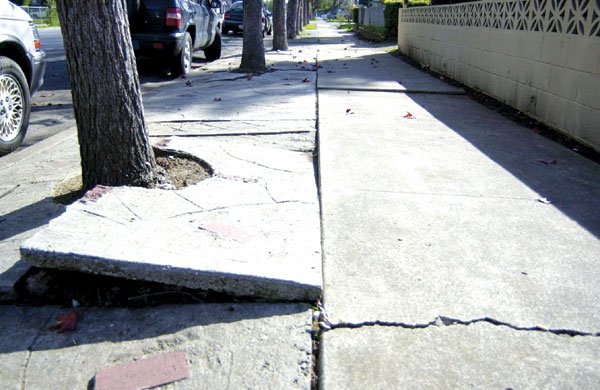Gilroy
– The city may soon help more homeowners pay to repair buckled
sidewalks, but probably not before officials shift a greater
portion of the liability for injuries on residents.
Councilmen are considering adopting a
”
Sidewalk Liability
”
ordinance modeled on other cities in the region, even as the
city’s 50/50 program, which splits the cost of sidewalk repairs
with homeowners, remains underfunded and backlogged with
applicants.
Gilroy – The city may soon help more homeowners pay to repair buckled sidewalks, but probably not before officials shift a greater portion of the liability for injuries on residents.
Councilmen are considering adopting a “Sidewalk Liability” ordinance modeled on other cities in the region, even as the city’s 50/50 program, which splits the cost of sidewalk repairs with homeowners, remains underfunded and backlogged with applicants.
State law requires homeowners to maintain their sidewalks but does not state they are specifically liable if they do not fix them, according to City Attorney Linda Callon.
“The fact is that persons that claim an injury sue the agency in charge of the right of way,” she said.
“Trip and falls” represent more than half the claims against Gilroy, according to City Administrator Jay Baksa. The city typically submits the claims to a regional insurance pool, an investigation is conducted.
City leaders are now discussing an ordinance – similar to ones in San Jose and a dozen other Bay Area cities – that explicitly renders the owner liable for injuries caused by sidewalks in disrepair. A sample ordinance distributed to councilmen at a Jan. 14 retreat includes language that allows the city to conduct the repairs itself and to enforce payment by placing a tax lien on the property.
Administrative Services Director Mike Dorn said that whenever he has sat in on a liability hearing between a property owner, accident victim, and insurance company, the “first question is almost always ‘Does the city have an ordinance taking on some of the liability?’… Without the ordinance, homeowners’ insurance won’t pay damages.”
And neither will the city, since it has run out of 50/50 funding half way into the fiscal year with 93 applicants – and counting – still awaiting assistance.
City Engineer Albert Signorotti, who manages the 50/50 program, said the city burned through roughly $83,540 on 42 separate repair projects and that new funds will not be available until July, the start of the 2005-06 fiscal year.
“A few people are out getting estimates,” Signorotti said. “Once those are done there’s only a few hundred dollars left.”
He said 15 to 20 of the people on the waiting list were “kicked down” from previous years, some because they failed to respond in time to the city’s notices. At the start of each fiscal year, the city mails out letters to everyone who failed to receive 50/50 funding the previous year. Each year the city provides assistance on a “first-come first-serve basis,” Signorotti said, meaning that homeowners who have been on the waiting list are not guaranteed assistance unless they respond quickly.
Signorotti predicted, however, that the city “should be able to do them all,” since the program’s funding will almost double in 2006, when the city inches back to its original level of support for the program.
In 1994, the city began adding $100,000 per year to a sidewalk repair reserve fund, with the goal of setting aside $1 million to finance ongoing repairs. Half of the annual contribution came from the city’s general fund balance (money that has not been designated for a specific use), but that transfer was cut in half in 2002 and ultimately suspended in 2003 due to budget shortfalls. City officials expect a recent ballot measure to allow them to once again begin supporting the program.
“The last couple of years we haven’t been able to do that because our general fund has been under such attack by the state,” Baksa said. “We should be back on track with Measure 1A in about a year. When we are able to start putting general fund money in, we will be able to catch up with the backlog.”
The average sidewalk repair ranges from $3,000 to $4,000, although the price can reach as high as $30,000, depending on the nature of the work, according to Signorotti. The city generally pays for at least half of the repair costs under the program, but that may be little consolation to some who may soon face greater liability if people get injured along their portion of sidewalk.
Rose Farotto, who moved to her home on the corner of Third Street and Filice Drive in 1957, is aware she could be liable if someone trips on the buckled sidewalk in front of her home – especially if the city passes the sidewalk liability ordinance. But it appears she may not be the only party responsible for the condition of her sidewalk.
“The city had us plant these trees,” said Farotto, who said she would consider repairing her sidewalk if the city picked up more of the bill. “As long as we’ve had these trees, there’s no use … The sidewalks are all ruined.”













